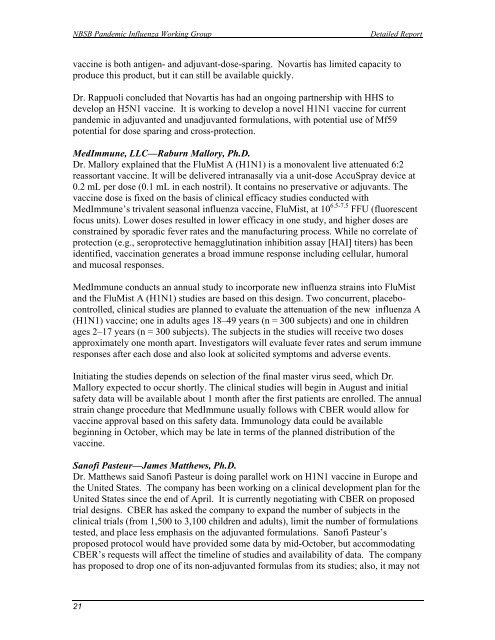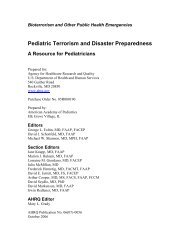H1N1 COUNTERMEASURES STRATEGY AND ... - PHE Home
H1N1 COUNTERMEASURES STRATEGY AND ... - PHE Home
H1N1 COUNTERMEASURES STRATEGY AND ... - PHE Home
Create successful ePaper yourself
Turn your PDF publications into a flip-book with our unique Google optimized e-Paper software.
NBSB Pandemic Influenza Working Group<br />
Detailed Report<br />
vaccine is both antigen- and adjuvant-dose-sparing. Novartis has limited capacity to<br />
produce this product, but it can still be available quickly.<br />
Dr. Rappuoli concluded that Novartis has had an ongoing partnership with HHS to<br />
develop an H5N1 vaccine. It is working to develop a novel <strong>H1N1</strong> vaccine for current<br />
pandemic in adjuvanted and unadjuvanted formulations, with potential use of Mf59<br />
potential for dose sparing and cross-protection.<br />
MedImmune, LLC—Raburn Mallory, Ph.D.<br />
Dr. Mallory explained that the FluMist A (<strong>H1N1</strong>) is a monovalent live attenuated 6:2<br />
reassortant vaccine. It will be delivered intranasally via a unit-dose AccuSpray device at<br />
0.2 mL per dose (0.1 mL in each nostril). It contains no preservative or adjuvants. The<br />
vaccine dose is fixed on the basis of clinical efficacy studies conducted with<br />
MedImmune’s trivalent seasonal influenza vaccine, FluMist, at 10 6.5-7.5 FFU (fluorescent<br />
focus units). Lower doses resulted in lower efficacy in one study, and higher doses are<br />
constrained by sporadic fever rates and the manufacturing process. While no correlate of<br />
protection (e.g., seroprotective hemagglutination inhibition assay [HAI] titers) has been<br />
identified, vaccination generates a broad immune response including cellular, humoral<br />
and mucosal responses.<br />
MedImmune conducts an annual study to incorporate new influenza strains into FluMist<br />
and the FluMist A (<strong>H1N1</strong>) studies are based on this design. Two concurrent, placebocontrolled,<br />
clinical studies are planned to evaluate the attenuation of the new influenza A<br />
(<strong>H1N1</strong>) vaccine; one in adults ages 18–49 years (n = 300 subjects) and one in children<br />
ages 2–17 years (n = 300 subjects). The subjects in the studies will receive two doses<br />
approximately one month apart. Investigators will evaluate fever rates and serum immune<br />
responses after each dose and also look at solicited symptoms and adverse events.<br />
Initiating the studies depends on selection of the final master virus seed, which Dr.<br />
Mallory expected to occur shortly. The clinical studies will begin in August and initial<br />
safety data will be available about 1 month after the first patients are enrolled. The annual<br />
strain change procedure that MedImmune usually follows with CBER would allow for<br />
vaccine approval based on this safety data. Immunology data could be available<br />
beginning in October, which may be late in terms of the planned distribution of the<br />
vaccine.<br />
Sanofi Pasteur—James Matthews, Ph.D.<br />
Dr. Matthews said Sanofi Pasteur is doing parallel work on <strong>H1N1</strong> vaccine in Europe and<br />
the United States. The company has been working on a clinical development plan for the<br />
United States since the end of April. It is currently negotiating with CBER on proposed<br />
trial designs. CBER has asked the company to expand the number of subjects in the<br />
clinical trials (from 1,500 to 3,100 children and adults), limit the number of formulations<br />
tested, and place less emphasis on the adjuvanted formulations. Sanofi Pasteur’s<br />
proposed protocol would have provided some data by mid-October, but accommodating<br />
CBER’s requests will affect the timeline of studies and availability of data. The company<br />
has proposed to drop one of its non-adjuvanted formulas from its studies; also, it may not<br />
21
















